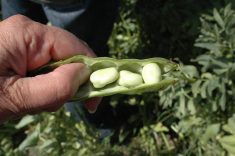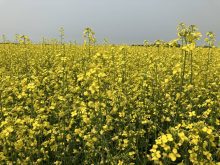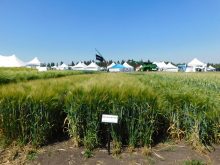In an age where research projects based on three years of field work is the norm – one project conducted by a series of soil scientists at the Agriculture Canada Lethbridge Research Centre stands out.
Last month, they seeded the 101st crops on the Rotation ABC and Rotation U plots, continuing work that began in 1911.
The experiments were designed to find the most profitable crop sequences on dryland and under irrigation in southern Alberta, and to find cropping systems that would maintain soil fertility. The rotation studies were to complement small-plot cultural experiments designed to find the effects of depths of plowing, timing of seeding, and other factors affecting crop emergence, development, ripening and quality.
Read Also

New crop insurer policy enables easier startup for faba beans
Agriculture Financial Services Corporation updated its normals for faba beans, which may open the door for more Canadian producers to feel comfortable growing the pulse crop in the future.
Rotation ABC has had continuous wheat, wheat-fallow and wheat-wheat-fallow, since 1911, perhaps because of its simplicity. On part of each plot, N fertilizer has been used since 1967 and inorganic P fertilizer since 1972. Farming methods have changed as tractors replaced horses, mouldboard plows were replaced by disc tillage equipment, then a Noble blade (which was less necessary as herbicides became available) and now low-disturbance direct seeding. A plot of original grassland was preserved, but weedy grasses such as crested wheatgrass have invaded it to some extent.
Rotation U originally focused on “hoe crops,” such as potatoes and sugar beets, and forage crops for horses and other livestock. Mechanization led to wheat replacing the specialty crops and manure is now applied in some treatments.
Long-term rotation plots were established at six sites across the Prairies at the same time as the native grassland was first broken for cropping. A “whole alphabet” of cropping sequences was included in the early years, when settlers needed information on every aspect of farming the Prairies. Over the years, most of the sites and treatments have been dropped as managers and scientists opted to focus limited dollars on research that would provide results sooner, or answer questions that seemed more urgent.
But the century-old research has unique value, partly of the archived records that document it. The reports include 100 years of weather data, copious notes, and archived samples of soil, grain and straw. Scientists can analyze archived samples using the same methods for old and new samples so any changes over time are not due to different techniques. The scientists only take soil samples every 10 years.
A Century Of Records
Long-term rotations show trends, and cumulative rather than yearly effects, said Elwin Smith, lead scientist for the long-term rotations. Finding support for this research hasn’t always been easy, but views may be changing as the role of soil in the environment is recognized.
“Most of the time, we design experiments to give us answers to questions we think are important,” says Henry Janzen, a soil scientist who has been studying the soils in Rotation ABC for 26 years. “This experiment is different. Here, we’re listening to the land, trying to understand what it’s telling us. It’s humbling.”
Janzen and his colleague Ben Ellert study soil organic matter, trying to understand its formation, breakdown, and changes in its quality over time. Samples from the rotation plots showed organic matter dropped in the first decades of wheat fallow, then plateaued. Under unfertilized continuous wheat, organic matter dropped more slowly, taking about six decades to plateau a little above levels in fallowed land.
Ellert has used real-world information from the long-term rotations to test computer models. If a model predicts changes in soil organic matter that have been observed in the rotation plots, it’s likely to be accurate in other predictions.
Newton Lupwayi is studying the microbiology of soils of the various long-term rotation plots. Scientists from outside Agriculture Canada also use soil samples from the plots for various types of research. The plots may be coming into their own now as scientists in various disciplines use them to look at the effects of farming techniques and answer questions even bigger than agriculture.
———
“Thisexperimentis different.Here,we’re listeningtotheland, tryingtounderstand whatit’stellingus.It’s humbling.”
Henry Janzen














